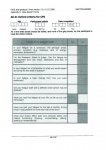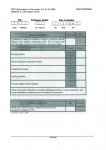Apologies if this point has been made before:
Overall health change CGI 1 or 2 ("very much better" or "much better"):
30 (48/158) 40 (62/154) 40 (63/156) 25 (40/158)
However, when one goes down through the scores, it becomes clear that quite a lot of those who gave their CGI score as 1 or 2, had poor scores (outside normal range) for either CFQ or the SF-36 PF or both.
One can't work out exact figures, but I think it's reasonable to do these approximations:
-----------------
APT:
30% CGI 1 or 2.
Max. 16% of them within both CFQ and SF-36-PF normal ranges (row 1, Table 1 (b)).
However, we have more information going from row 2 to row 3 i.e. at least 7% have CGI scores of 3-7 but within both CFQ and SF-36-PF normal ranges
--> means max 9% (=16-7) of the 30% with CGI 1 or 2 i.e. approximately 70+% of those gave their CGI score as 1 or 2 ("very much better" or "much better") following APT, have poor scores (outside normal range) for either CFQ or the SF-36 PF or both.
----------------
CBT:
40% CGI 1 or 2
Max. 30% of them within both CFQ and SF-36-PF normal ranges (row 1, Table 1 (b)).
However, we have more information going from row 2 to row 3 i.e. at least 6% have CGI scores of 3-7 but within both CFQ and SF-36-PF normal ranges
--> means max 24% =(30-6) of the 40% with CGI 1 or 2 i.e. approximately 40+% of those gave their CGI score as 1 or 2 ("very much better" or "much better") following APT, have poor scores (outside normal range) for either CFQ or the SF-36 PF or both.
----------------
GET:
40% CGI 1 or 2
Max. 28% of them within both CFQ and SF-36-PF normal ranges (row 1, Table 1 (b)).
However, we have more information going from row 2 to row 3 i.e. at least 6% have CGI scores of 3-7 but within both CFQ and SF-36-PF normal ranges
--> means max 22% =(28-6) of the 40% with CGI 1 or 2 i.e. approximately 45+% of those gave their CGI score as 1 or 2 ("very much better" or "much better") following APT, have poor scores (outside normal range) for either CFQ or the SF-36 PF or both.
----------
SMC:
25% CGI 1 or 2
Max. 15% of them within both CFQ and SF-36-PF normal ranges (row 1, Table 1 (b)).
However, we have more information going from row 2 to row 3 i.e. at least 7% have CGI scores of 3-7 but within both CFQ and SF-36-PF normal ranges
--> means max 8% =(15-7) of the 25% with CGI 1 or 2 i.e. approximately 68+% of those gave their CGI score as 1 or 2 ("very much better" or "much better") following APT, have poor scores (outside normal range) for either CFQ or the SF-36 PF or both.
-----------------
A numerical average is 55.75%
However, that ignores the fact that the number of individuals involved are bigger for CBT and GET.
If base the figures on the numbers with CGI scores of 1 or 2, it would be
(48*70%)+(62*40%)+(63*45%)+(40*68%)/48+62+63+40= 33.6+24.8+28.35+27.2/213= 113.95/213=53.5%
i.e. approximately 53.5% overall of those gave their CGI score as 1 or 2 ("very much better" or "much better"), did not satisfy one or both of the following:
within SF-36 PF normal range
within CFQ normal range
Presumably those who gave CGI scores of 1 did better than those who gave CGI scores of 2.
So probably 60+%, of those gave their CGI score 2 ("very much better" or "much better"), did not satisfy one or more of the following:
within SF-36 PF normal range (>=60)
within CFQ normal range (<=18)
This suggests it is not a good recovery criterion, using their own definition of "recovery".
Using the term "specificity", It means a CGI score of 2 would have 40% (or less) specificity for ensuring all of the following are met:
(i) within SF-36 PF normal range (>=60)
(ii) within CFQ normal range (Likert) (<=18)
If one had a stricter recovery definition, for example SF-36 PF >=85 and CFQ (bimodal) <=3, one could imagine that the figures would be much worse, probably much much worse, again.
=====================================
(These figures below aren't a whole lot different i.e. the "Oxford criteria not met" criterion doesn't affect too much the numbers we have access to).
If one looks at: "Overall health change CGI 1 or 2" vs
"Overall health change CGI 1 or 2"
+Oxford Criteria not met
+ within SF-36 PF normal range
+ within CFQ normal range
there is quite a difference:
APT: 30% vs 8%
CBT: 40% vs 22%
GET: 40% vs 22%
SMC: 25% vs 7%
(the denominators are different so will just approximate).
This means that:
- (i) with APT
(30-8%)=22/30 =73.3333% of those who put CGI of 1 or 2 did not satisfy one or more of the following:
Oxford Criteria not met
or
within SF-36 PF normal range
or
within CFQ normal range
- (ii) with CBT:
(40-22)=18/40=45% of those who put CGI of 1 or 2 did not satisfy one or more of the following:
Oxford Criteria not met
or
within SF-36 PF normal range
or
within CFQ normal range
- (iii) with GET:
(40-22)=18/40=45% of those who put CGI of 1 or 2 did not satisfy one one or more of the following:
Oxford Criteria not met
or
within SF-36 PF normal range
or
within CFQ normal range
- (iii) with SMC:
(25-7)=18/25=72% of those who put CGI of 1 or 2 did not satisfy one or more of the following:
Oxford Criteria not met
or
within SF-36 PF normal range
or
within CFQ normal range
A numerical average is 58.8%
However, that ignores the fact that the number of individuals involved are bigger for CBT and GET.
If base the figures on the numbers with CGI scores of 1 or 2, it would be
(48*73.33333%)+(62*45%)+(63*45%)+(40*72%)/48+62+63+40= 35.2+ 27.9+28.35+28.8/213=120.25/213=56.5%
i.e. approximately 56.6% overall of those gave their CGI score as 1 or 2 ("very much better" or "much better"), did not satisfy one or more of the following:
Oxford Criteria not met
or
within SF-36 PF normal range
or
within CFQ normal range
Presumably those who gave CGI scores of 1 did better than those who gave CGI scores of 2.
So probably 60%, maybe 70+% of those gave their CGI score 2 ("very much better" or "much better"), did not satisfy one or more of the following:
Oxford Criteria not met (i.e. they still satisfied the Oxford criteria)
or
within SF-36 PF normal range
or
within CFQ normal range.
This suggests it is not a good recovery criterion, using their own definition of "recovery".
Using the term "specificity", It means a CGI score of 2 would have 30-40% (or less) specificity for ensuring all of the following are met:
(i) Oxford Criteria not met
(ii) within SF-36 PF normal range
(iii) within CFQ normal range.
If one had a stricter recovery definition, for example SF-36 PF >=85 and CFQ (bimodal) <=3, one could imagine that the figures would be much worse, probably much much worse, again.


